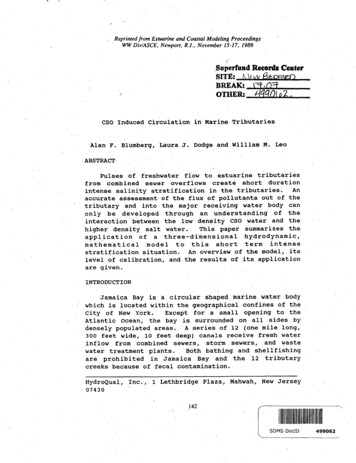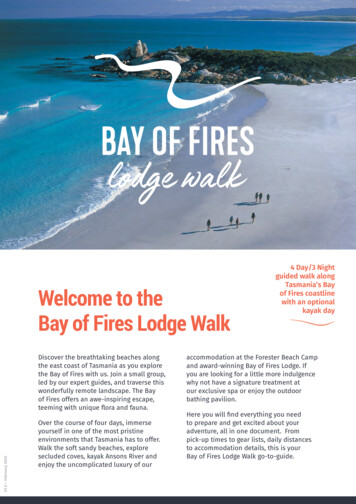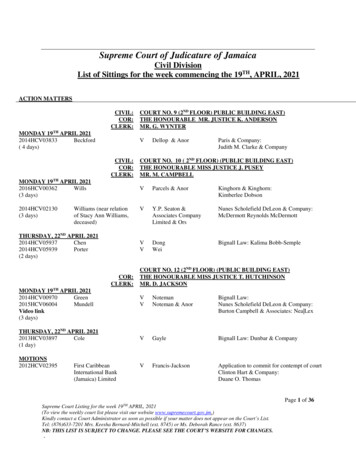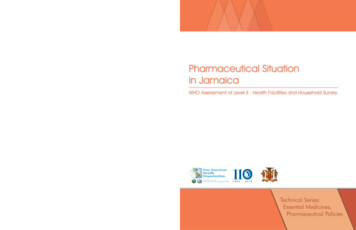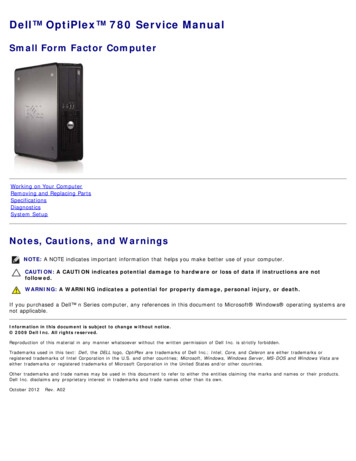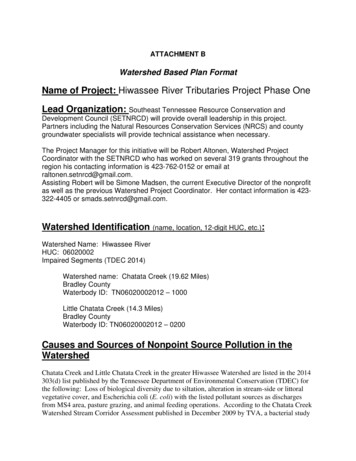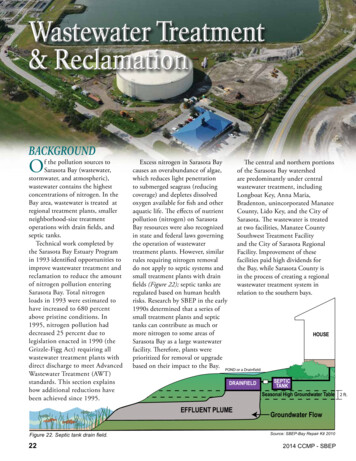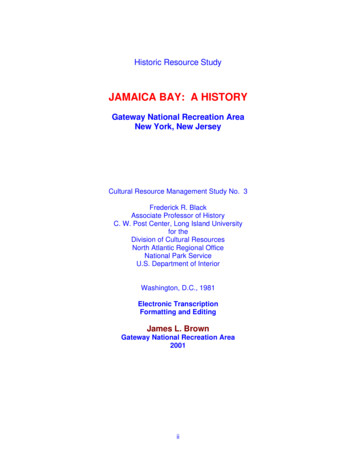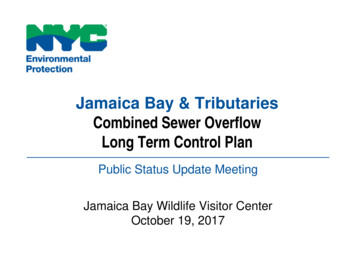
Transcription
Jamaica Bay & TributariesCombined Sewer OverflowLong Term Control PlanPublic Status Update MeetingJamaica Bay Wildlife Visitor CenterOctober 19, 2017
AgendaTopicSpeaker1Welcome & IntroductionsMikelle Adgate2Jamaica Bay & Tribs LTCP Time ExtensionKeith Mahoney3Planned Projects in Jamaica Bay WatershedMikelle Adgate4Southeast Queens Program OverviewMikelle Adgate5Green Infrastructure and Bluebelt ProjectsMikelle Adgate6Public Outreach and EducationMikelle Adgate7Discussion and Q & A SessionAll2
Welcome & IntroductionsMikelle AdgateDirector of Stormwater OutreachDEP - BPA3
Jamaica Bay & Tributaries LTCPTime ExtensionKeith MahoneyDirector of Water Quality PlanningDEP - BEDC4
What is a LTCP and CSO Consent Order?Long Term Control Plan (LTCP)identifies appropriate CSO controls to achieveapplicable water quality standardsconsistent with the Federal CSO Policy and Clean Water ActCSO Consent Orderan agreement between NYC and DEC that settlespast legal disputes without prolonged litigationDEC requires DEP to develop LTCPs and mitigate CSOs5
Jamaica Bay and Tributaries6
Committed CSO Mitigation ProjectsConstruction CostProject( Millions, 2011)1Automation of Regulator JA-2 2Complete2Spring Creek Auxiliary WWTP Upgrade 87Complete326th Ward WWTP Drainage Area Sewer Cleaning 4Complete4Hendrix Creek Dredging 13Complete5Regulator Improvements at J3, J6 & J14 7Complete6New Parallel Sewer West Interceptor 20Complete7New Bergen Basin Lateral Sewer 12Ongoing826th Ward WWTP Wet Weather Stabilization 128Ongoing926th Ward High Level Sewer Separation 300OngoingTBDOngoing10 Green InfrastructureTotal2Status6 573 M97
Projected Jamaica Bay Wet Weather 005, 006RockawayOutfalls3Total4000BEFORE(3,578 MGY)3500CSO Discharge Volume (MGY)LocationCSO Volume(MG)140%3000AFTER(2,150 15----3,5782,1505138Notes:1) CSO volumes and activations frequency are based upon overflows at the respective regulatorweirs and do not account for stormwater contributions to the outfall downstream of the regulatorwith the exception of Thurston Basin which is the sum of the CSO discharges downstream ofRegulators JA-06, JA-07 and JA-08.2) LTCP Baseline After implementation of WWFP recommended Green/Grey projects.3) Rockaway CSOs do not activate during the typical 2008 rainfall year.4) Preliminary model results only; final values pending receipt of final delineations of the MS4subcatchments and stormwater categories from BWSO.Pre-WWFPCI-004,005,00626W-004JAM-003ALTCP Baseline(After Implementation of WWFPRecommended Grey/Green Projects)Tank Overflow26W-005JAM-00326W-003JAM-006JAM-005/007* Approximately11 BGY of storm water being discharged into Jamaica Bay andan additional 6 BGY of flow entering Head of Bay from Nassau County.8
Revised CSO LTCP Submittal Date DEP requested and DEC approved a one year extension for the Jamaica Bay LTCPsubmittal to June 2018, so that DEP could coordinate with other ongoing projectsActivities1Evaluate impacts and needs of JFKAirport ExpansionBenefit Preliminary estimates of capacity needs can be usedin regional planning effortsConsider relocation of interceptor for improved access2Coordinate with JamaicaRedevelopment Zone sewer capacityimprovements Improved calibration of upstream collection systemAllows for modeling of RDII in upstream trunk sewersFacilitates integrated planning efforts3Consider results of Spring CreekDisinfection Pilot Study Provides a better understanding of the effectiveness ofdisinfection processes and long term maintenanceneeds4Coordinate with BWSO’s storm sewerbuild-out program Identify overlapping or complimentary projectsEvaluate opportunities for expediting collection systemcapacity improvements5Evaluate opportunities to relievecapacity limitations of upstream trunksewers Flooding reliefImproved conveyance to WWTPReduce CSOs6Coordinate GI and Bluebelt Projectswith MS4 program Enables integrated planning and consideration of theWQ impacts of stormwater in addition to CSO9
Jamaica Bay LTCP StatusTODAY10
Planned Projectsin Jamaica Bay WatershedMikelle AdgateDirector of Stormwater OutreachDEP - BPA11
Regional Ongoing and New Projects1) Jamaica Rezoning Plan11 2 Preserve lower density neighborhoods:low-rise mixed building, 1- and 20- familycharacter Create new, affordable housingopportunities: Inclusionary zoning to limitdevelopment of unaffordable housing units Urban Renewal Area: Includes signatureparks, residential, hotel, office/retail, publicparking432) Jamaica InfrastructureImprovements2 The Sutphin Underpass (Complete):Improve pedestrian circulation; create newretail space Atlantic Avenue Extension: Create oneway streets; develop 3 new public parks Station Plaza Redevelopment: Createwider sidewalks and turning lanes; createnew plazas and subway entrances4) Watershed Restoration PilotStudies3) Far Rockaway UrbanDesign and Reconstruction3 Comprehensive urban design plan andstreetscape improvements: encouragesafer pedestrian circulation andenvironmental resiliency in storms Storefront improvements: support smallbusinesses with renovation projectsSources: http://www.nycedc.com/project/ and http://www.nyc.gov/html/new/Jamaica bay watershed.shtml Oyster and Eel Grass Restoration: small scaleprojects to establish costs, benefits, and success Ribbed Mussel Restoration: evaluate thefiltering capacity and population densitiesrequired for water quality improvements Salt Marshes and Beach Habitats: identify andinventory sites for restoration; preserve recentlyrestored areas Algae and Sea Lettuce Harvesting: determineif skimmer boats are a feasible, cost-effectivemethod to remove plants and improve DOconcentrations12
Regional Ongoing and New Projects65) JFK Expansion567 Interconnect Terminals: redevelop olderterminals, expanding newer terminals Expand Taxiways: reduce ground delaysand add new flight slots Redesign Airport Roadways: develop a“ring road” configuration for easier, quickeraccess Centralize and Expand Parking Lots:incorporate into “ring road” with short/longterm parking options Provide World-Class Amenities:including fine dining and best-in-classretail, hotels, and conference facilities6) Southeast QueensDrainage Plan Flooding Remediation: 1.7 billionallocated over the next 10 years towardsinfrastructure improvement to alleviateflooding (mainly in Community Boards 12and 13) Grey/Green Infrastructure: installation ofbioswales and other green spaces toabsorb rainwater runoff Storm Sewer Infrastructure: installation ofcatch basins, storm sewers and High LevelStorms Sewers to improve stormwaterdrainage and reduce flooding577) NY Rising New York City has 15 NY RisingCommunities distributed over the fiveboroughs. The recovery and resiliency efforts willprovide a unique combination of social andinfrastructure-based assistance tocommunities, some of which are lowincome, hard hit by Superstorm Sandy. Each locality is eligible for between 3million and 25 million of CommunityDevelopment Block Grant (CDBG) funding,as it implements new and innovativestrategies that aim to establish a strongerand better or- ml/press gions/new-york-city13
Downtown Jamaica Redevelopment Jamaica Redevelopment Zone (1,770 acres)will create new business and residential districtsthat will increase sewage flows to the JamaicaWWTP The three existing sanitary trunk sewers thatservice this area exhibit significant capacitylimitations during peak dry and wet weatherconditions Goal: Evaluate alternatives to conveyadditional flow from the RedevelopmentZone along with relieving the inundatednearby trunk sewers to the Jamaica WWTP DEP intends to conduct an 18-month evaluationto better quantify flow rates, constructability,and develop alternatives. Preliminary Alternatives Under Consideration: New Sanitary Pump Station and Force Main New Gravity Trunk Sewers Clean-Out/Improvements to Existing Trunk Sewers15
Flow Monitoring EffortsJamaica RedevelopmentZone Flow Monitoring16
Southeast QueensProgram Overview18
Flooding in Southeast Queens Flooding is not a newproblem in SoutheastQueensPlaceholder for new SEQmap Increasing rainfall, loss ofpermeable surfaces, lackof drainage infrastructurehave worsenedconditions Over the past ten years,Community Boards 12and 13 have had moreflooding complaints thanany other area of NewYork City19
OneNYC OneNYC identifies alleviatingflooding in Southeast Queens as apriority initiative The 10 Year Capital Budgetallocates 1.7 billion over the nextdecade to plan and begin full sewerbuildout and to provide short termrelief wherever possible Full buildout requires approximately450 miles of new storm sewers, andupgrade 260 miles of sanitarysewers and 30 miles of combinedsewers over many years20
The Southeast Queens ProgramThe City has funded a 1.7 billion capital program to respond to the dualchallenge of increased/more intense rainfall and lack of stormwaterinfrastructure in Southeast Queens. The program is designed to:1. Accelerate the planning and design work to build large trunk sewers2. Build early action storm sewers in the hardest hit areas as quickly aspossible3. Intercept as much stormwater before it gets to the storm sewer systemas possible using green infrastructure4. Partner with the community to share information on steps propertyowners can take21
The Basics: Trunk Sewer ConstructionStrategy:Accelerate the planning and design workto build large trunk sewersProcess Overview:1. Develop drainage plan for SoutheastQueens (completed 2007)2. Allocate budget for projects in 10Year Capital Plan3. Deliver project scopes to DDC4. DDC designs, bids out, and managesthe construction of trunk sewers22
Trunk Sewers Overview Southeast Queens is served by fourtrunk sewer lines. These trunk sewersare the main highways for stormwaterto flow from the neighborhood streetsto Jamaica Bay. They are called the:1. 150th Street Spine2. Guy Brewer Blvd Spine3. Farmers Blvd Spine4. Springfield/Laurelton Spine Trunk sewer construction begins atthe southernmost point and movesnorthward in phases23
The Basics: Early Action Sewer ConnectionsStrategy:Build early action storm sewers in thehardest hit areas as quickly as possibleProcess Overview:1. Accelerate scoped projectsscheduled for future construction2. Use complaint data to identifyhardest hit areas3. Complete wet and dry weather siteinvestigations to identify root causes4. Design and construct site-specificsolutions24
Data Analysis DEP examined five years of 311 data toidentify the areas with the highest density offlooding complaints; 50 priority grid areaswere identified Teams of engineers were sent to each of thegrids during wet and dry weather tocatalogue ponding conditions, existinginfrastructure, and street defects. This data was then mapped, block by block,for each grid. After the field analyses were complete, eachgrid was analyzed for site-specific solutions.These solutions can include: Drainage plan sewers (under “when andwhere” contracts) Storm sewer extensions Green infrastructure Street regrading or curb installation Private property protections25
Green Infrastructure andBluebelt Projects26
The Basics: Green InfrastructureStrategy:Intercept as much stormwater before it gets to the storm sewer system as possible usinggreen infrastructureProcess Overview:1. Identify potential public properties to site green infrastructure, in partnership withother city agencies2. Evaluate feasibility/soil conditions3. Design and build green infrastructure4. Collect data to evaluate system performanceParties Involved:27
Green Infrastructure in Jamaica Bay Area-wide Right of Way Projects Select Right of Way Projects in SE Queens Public Property Retrofits – combined and separate areas Cloudburst Planning and Pilots Grant Program for private property ownersRain GardensGrant Project28
Public Property and ROW – Jamaica Bay, BK29
Public Property and ROW – Jamaica Bay, BKRain GardensJHS 218 – BeforeJHS 218 – After30
Public Property and ROW – Jamaica Bay, QN31
Public Property and ROW – Jamaica Bay, QNSouth Jamaica HousesFuture Concept (Dry)South Jamaica HousesFuture Concept (Wet)32
SE Queens & Cloudburst Green Infrastructure SummaryLocationStatus/Next StepTechniquesRight-of-way (ROW)In designConstruction start 2018Rain Gardens (Approx. 200)PS 40In constructionConstruction complete 2020Rain GardensDownspout DisconnectionPS 50In constructionConstruction complete 2018Rain GardensSubsurface Retention SystemSouth JamaicaHouses I & II, St.Albans, Beach 67th StIn concept/planningDesign start 2018TBD (Cloudburst designs, Runoff Capture)Roy Wilkins ParkIn designConstruction start spring 2019Pond Restoration/ExpansionROW Runoff CaptureRailroad ParkIn designConstruction start summer 2020ROW Runoff CaptureDet. Keith WilliamsParkIn designConstruction start fall 2020ROW Runoff Capture33
Bluebelt Projects Bluebelts are integrated drainage systems that combine conventional storm sewersand natural wetlands and streams to responsibly manage stormwater. Bluebelts provide community open spaces and diverse wildlife habitats and preservenatural drainage corridors, including streams, ponds, and other wetland areas. Bluebelt projects in Southeast Queens include Brookville Triangle (in design), BaisleyPond (in construction), Twin Ponds (in construction), and Springfield Lake (completed).Springfield Lake Bluebelt34
Public Outreach and Education35
Public Education and Outreach36
Next StepsLTCP Due6/30/18ExistingInformationReviewDataCollection ingTodayAlternativesDevelopment& EvaluationLTCPDEC ReviewAlternativesMeetingFinal PlanReview MeetingSpring 2018TBDONGOING PUBLIC/STAKEHOLDER INPUT37
Additional Information on CSO LTCP Go to www.nyc.gov/dep/ltcp to access: Presentation and handouts Submitted CSO LTCPs CSO Consent Order NYC’s Green Infrastructure Plan NYC Waterbody Advisory Program Upcoming meeting announcements Other LTCP updates38
Discussion and Q&A Session39
7 Committed CSO Mitigation Projects Project Construction Cost ( Millions, 2011) Status 1 Automation of Regulator JA-2 2 Complete 2 Spring Creek Auxiliary WWTP Upgrade 87 Complete 3 26th Ward WWTP Drainage Area Sewer Cleaning 4 Complete 4 Hendrix Creek Dredging 13 Complete 5 Regulator Improvements at J3, J6 & J14 7 Complete 6 New Parallel Sewer West Interceptor 20 Complete

